warning light SATURN ASTRA 2008 User Guide
[x] Cancel search | Manufacturer: SATURN, Model Year: 2008, Model line: ASTRA, Model: SATURN ASTRA 2008Pages: 304, PDF Size: 1.92 MB
Page 110 of 304
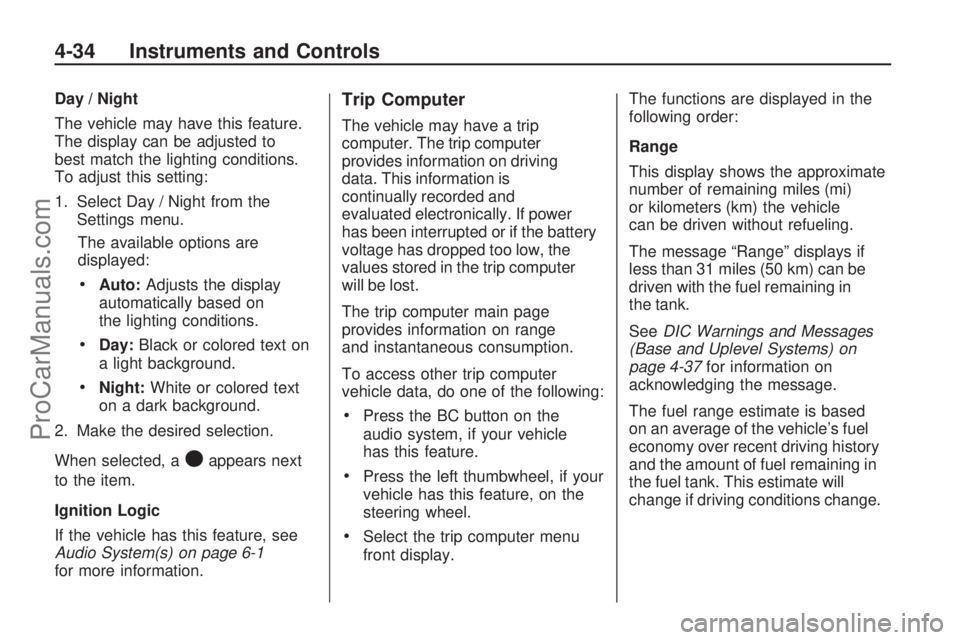
Day / Night
The vehicle may have this feature.
The display can be adjusted to
best match the lighting conditions.
To adjust this setting:
1. Select Day / Night from the
Settings menu.
The available options are
displayed:
Auto:Adjusts the display
automatically based on
the lighting conditions.
Day:Black or colored text on
a light background.
Night:White or colored text
on a dark background.
2. Make the desired selection.
When selected, a
Oappears next
to the item.
Ignition Logic
If the vehicle has this feature, see
Audio System(s) on page 6-1
for more information.
Trip Computer
The vehicle may have a trip
computer. The trip computer
provides information on driving
data. This information is
continually recorded and
evaluated electronically. If power
has been interrupted or if the battery
voltage has dropped too low, the
values stored in the trip computer
will be lost.
The trip computer main page
provides information on range
and instantaneous consumption.
To access other trip computer
vehicle data, do one of the following:
Press the BC button on the
audio system, if your vehicle
has this feature.
Press the left thumbwheel, if your
vehicle has this feature, on the
steering wheel.
Select the trip computer menu
front display.The functions are displayed in the
following order:
Range
This display shows the approximate
number of remaining miles (mi)
or kilometers (km) the vehicle
can be driven without refueling.
The message “Range” displays if
less than 31 miles (50 km) can be
driven with the fuel remaining in
the tank.
SeeDIC Warnings and Messages
(Base and Uplevel Systems) on
page 4-37for information on
acknowledging the message.
The fuel range estimate is based
on an average of the vehicle’s fuel
economy over recent driving history
and the amount of fuel remaining in
the fuel tank. This estimate will
change if driving conditions change.
4-34 Instruments and Controls
ProCarManuals.com
Page 113 of 304
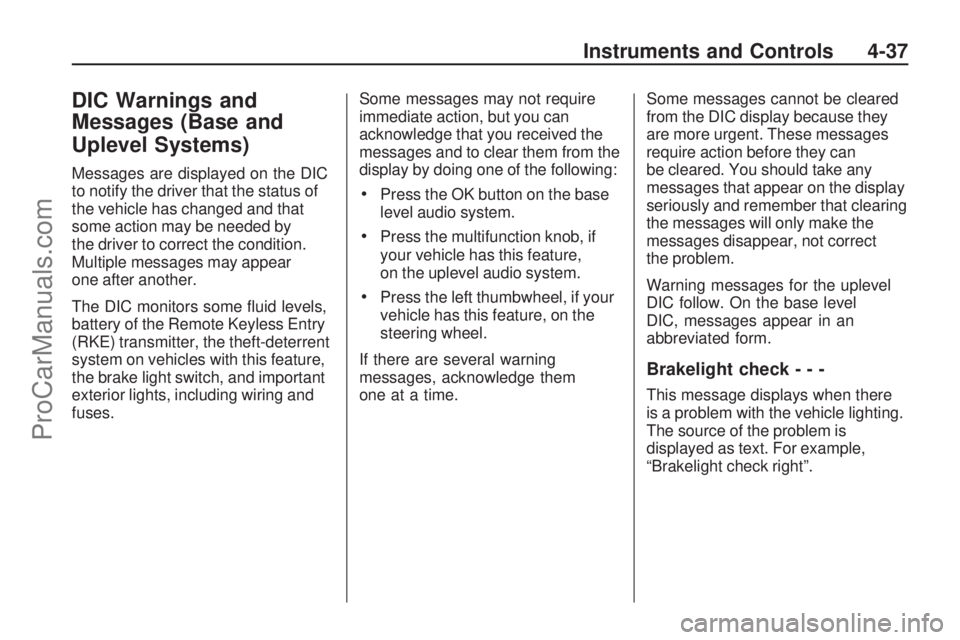
DIC Warnings and
Messages (Base and
Uplevel Systems)
Messages are displayed on the DIC
to notify the driver that the status of
the vehicle has changed and that
some action may be needed by
the driver to correct the condition.
Multiple messages may appear
one after another.
The DIC monitors some �uid levels,
battery of the Remote Keyless Entry
(RKE) transmitter, the theft-deterrent
system on vehicles with this feature,
the brake light switch, and important
exterior lights, including wiring and
fuses.Some messages may not require
immediate action, but you can
acknowledge that you received the
messages and to clear them from the
display by doing one of the following:
Press the OK button on the base
level audio system.
Press the multifunction knob, if
your vehicle has this feature,
on the uplevel audio system.
Press the left thumbwheel, if your
vehicle has this feature, on the
steering wheel.
If there are several warning
messages, acknowledge them
one at a time.Some messages cannot be cleared
from the DIC display because they
are more urgent. These messages
require action before they can
be cleared. You should take any
messages that appear on the display
seriously and remember that clearing
the messages will only make the
messages disappear, not correct
the problem.
Warning messages for the uplevel
DIC follow. On the base level
DIC, messages appear in an
abbreviated form.
Brakelight check---
This message displays when there
is a problem with the vehicle lighting.
The source of the problem is
displayed as text. For example,
“Brakelight check right”.
Instruments and Controls 4-37
ProCarManuals.com
Page 155 of 304
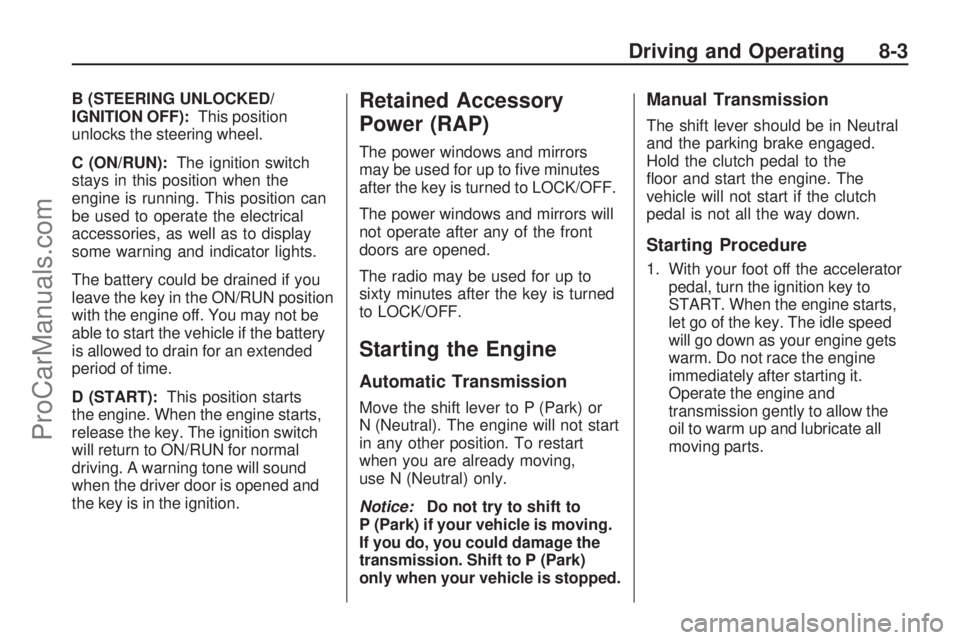
B (STEERING UNLOCKED/
IGNITION OFF):This position
unlocks the steering wheel.
C (ON/RUN):The ignition switch
stays in this position when the
engine is running. This position can
be used to operate the electrical
accessories, as well as to display
some warning and indicator lights.
The battery could be drained if you
leave the key in the ON/RUN position
with the engine off. You may not be
able to start the vehicle if the battery
is allowed to drain for an extended
period of time.
D (START):This position starts
the engine. When the engine starts,
release the key. The ignition switch
will return to ON/RUN for normal
driving. A warning tone will sound
when the driver door is opened and
the key is in the ignition.Retained Accessory
Power (RAP)
The power windows and mirrors
may be used for up to �ve minutes
after the key is turned to LOCK/OFF.
The power windows and mirrors will
not operate after any of the front
doors are opened.
The radio may be used for up to
sixty minutes after the key is turned
to LOCK/OFF.
Starting the Engine
Automatic Transmission
Move the shift lever to P (Park) or
N (Neutral). The engine will not start
in any other position. To restart
when you are already moving,
use N (Neutral) only.
Notice:Do not try to shift to
P (Park) if your vehicle is moving.
If you do, you could damage the
transmission. Shift to P (Park)
only when your vehicle is stopped.
Manual Transmission
The shift lever should be in Neutral
and the parking brake engaged.
Hold the clutch pedal to the
�oor and start the engine. The
vehicle will not start if the clutch
pedal is not all the way down.
Starting Procedure
1. With your foot off the accelerator
pedal, turn the ignition key to
START. When the engine starts,
let go of the key. The idle speed
will go down as your engine gets
warm. Do not race the engine
immediately after starting it.
Operate the engine and
transmission gently to allow the
oil to warm up and lubricate all
moving parts.
Driving and Operating 8-3
ProCarManuals.com
Page 163 of 304
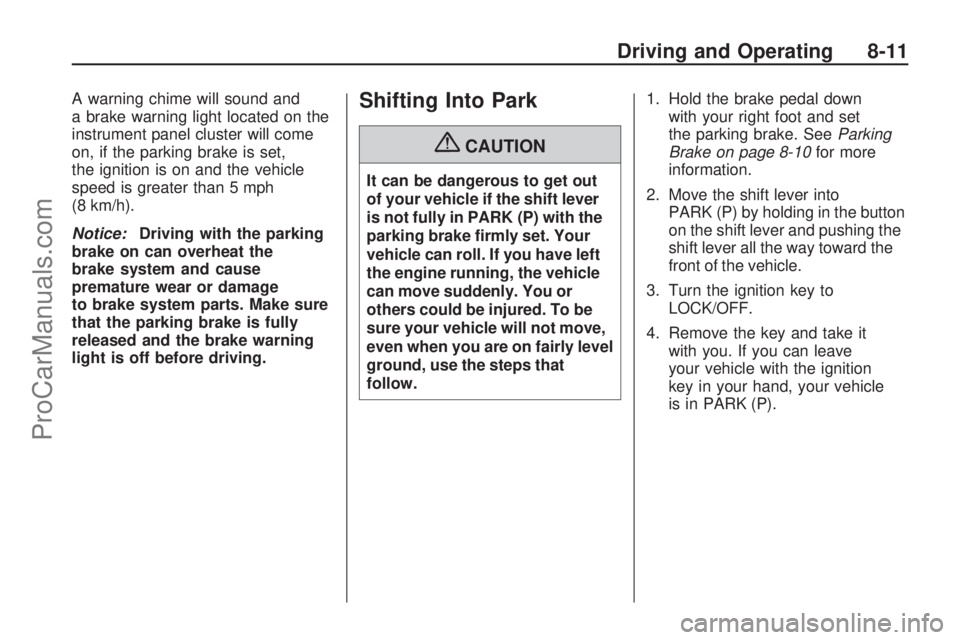
A warning chime will sound and
a brake warning light located on the
instrument panel cluster will come
on, if the parking brake is set,
the ignition is on and the vehicle
speed is greater than 5 mph
(8 km/h).
Notice:Driving with the parking
brake on can overheat the
brake system and cause
premature wear or damage
to brake system parts. Make sure
that the parking brake is fully
released and the brake warning
light is off before driving.Shifting Into Park
{CAUTION
It can be dangerous to get out
of your vehicle if the shift lever
is not fully in PARK (P) with the
parking brake �rmly set. Your
vehicle can roll. If you have left
the engine running, the vehicle
can move suddenly. You or
others could be injured. To be
sure your vehicle will not move,
even when you are on fairly level
ground, use the steps that
follow.1. Hold the brake pedal down
with your right foot and set
the parking brake. SeeParking
Brake on page 8-10for more
information.
2. Move the shift lever into
PARK (P) by holding in the button
on the shift lever and pushing the
shift lever all the way toward the
front of the vehicle.
3. Turn the ignition key to
LOCK/OFF.
4. Remove the key and take it
with you. If you can leave
your vehicle with the ignition
key in your hand, your vehicle
is in PARK (P).
Driving and Operating 8-11
ProCarManuals.com
Page 169 of 304

Medical research shows that alcohol
in a person’s system can make crash
injuries worse, especially injuries
to the brain, spinal cord, or heart.
This means that when anyone who
has been drinking — driver or
passenger — is in a crash, that
person’s chance of being killed or
permanently disabled is higher than
if the person had not been drinking.
Control of a Vehicle
The following three systems help
to control your vehicle while
driving — brakes, steering, and
accelerator. At times, as when
driving on snow or ice, it is easy to
ask more of those control systems
than the tires and road can provide.
Meaning, you can lose control of
your vehicle.
Adding non-dealer/non-retailer
accessories can affect your vehicle’s
performance. SeeAccessories
and Modifications on page 9-3.
Braking
SeeBrake System Warning Light on
page 4-17.
Braking action involves perception
time and reaction time. First, you
have to decide to push on the brake
pedal. That is perception time. Then
you have to bring up your foot and
do it. That is reaction time.
Average reaction time is about
three-fourths of a second. But that
is only an average. It might be
less with one driver and as long
as two or three seconds or
more with another. Age, physical
condition, alertness, coordination,
and eyesight all play a part.
So do alcohol, drugs, and
frustration. But even in three-fourths
of a second, a vehicle moving at
60 mph (100 km/h) travels 66 feet
(20 m). That could be a lot of
distance in an emergency, so
keeping enough space between
your vehicle and others is important.And, of course, actual stopping
distances vary greatly with the
surface of the road, whether it is
pavement or gravel; the condition of
the road, whether it is wet, dry, or icy;
tire tread; the condition of the brakes;
the weight of the vehicle; and the
amount of brake force applied.
Avoid needless heavy
braking. Some people drive in
spurts — heavy acceleration
followed by heavy braking — rather
than keeping pace with traffic. This
is a mistake. The brakes might not
have time to cool between hard
stops. The brakes will wear out much
faster if you do a lot of heavy braking.
If you keep pace with the traffic and
allow realistic following distances,
you will eliminate a lot of
unnecessary braking. That means
better braking and longer brake life.
Driving and Operating 8-17
ProCarManuals.com
Page 170 of 304
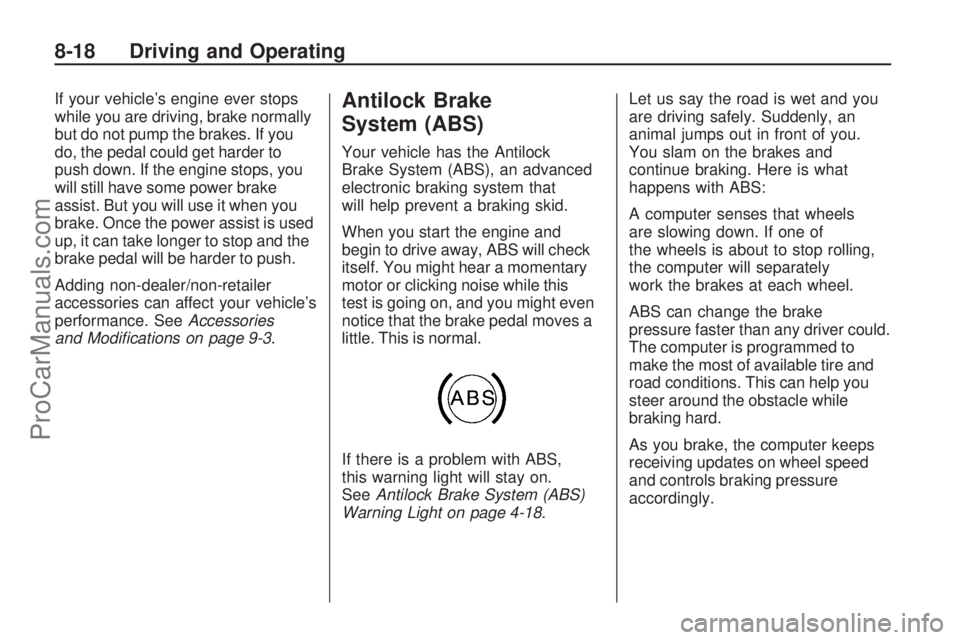
If your vehicle’s engine ever stops
while you are driving, brake normally
but do not pump the brakes. If you
do, the pedal could get harder to
push down. If the engine stops, you
will still have some power brake
assist. But you will use it when you
brake. Once the power assist is used
up, it can take longer to stop and the
brake pedal will be harder to push.
Adding non-dealer/non-retailer
accessories can affect your vehicle’s
performance. SeeAccessories
and Modifications on page 9-3.Antilock Brake
System (ABS)
Your vehicle has the Antilock
Brake System (ABS), an advanced
electronic braking system that
will help prevent a braking skid.
When you start the engine and
begin to drive away, ABS will check
itself. You might hear a momentary
motor or clicking noise while this
test is going on, and you might even
notice that the brake pedal moves a
little. This is normal.
If there is a problem with ABS,
this warning light will stay on.
SeeAntilock Brake System (ABS)
Warning Light on page 4-18.Let us say the road is wet and you
are driving safely. Suddenly, an
animal jumps out in front of you.
You slam on the brakes and
continue braking. Here is what
happens with ABS:
A computer senses that wheels
are slowing down. If one of
the wheels is about to stop rolling,
the computer will separately
work the brakes at each wheel.
ABS can change the brake
pressure faster than any driver could.
The computer is programmed to
make the most of available tire and
road conditions. This can help you
steer around the obstacle while
braking hard.
As you brake, the computer keeps
receiving updates on wheel speed
and controls braking pressure
accordingly.
8-18 Driving and Operating
ProCarManuals.com
Page 176 of 304

If your vehicle starts to slide, ease
your foot off the accelerator pedal
and quickly steer the way you want
the vehicle to go. If you start steering
quickly enough, your vehicle may
straighten out. Always be ready for a
second skid if it occurs.
Of course, traction is reduced when
water, snow, ice, gravel, or other
material is on the road. For safety,
you want to slow down and
adjust your driving to these
conditions. It is important to slow
down on slippery surfaces because
stopping distance is longer and
vehicle control more limited.
While driving on a surface with
reduced traction, try your best to
avoid sudden steering, acceleration,
or braking, including reducing
vehicle speed by shifting to a lower
gear. Any sudden changes could
cause the tires to slide. You
might not realize the surface isslippery until your vehicle is
skidding. Learn to recognize warning
clues — such as enough water,
ice, or packed snow on the road to
make a mirrored surface — and
slow down when you have any
doubt.
Remember: Any Antilock Brake
System (ABS) helps avoid only the
braking skid.
Driving at Night
Night driving is more dangerous
than day driving because some
drivers are likely to be impaired — by
alcohol or drugs, with night vision
problems, or by fatigue.
Night driving tips include:
Drive defensively.
Do not drink and drive.
Reduce headlamp glare by
adjusting the inside rearview
mirror.
Slow down and keep more space
between you and other vehicles
because headlamps can only
light up so much road ahead.
Watch for animals.
When tired, pull off the road.
Do not wear sunglasses.
Avoid staring directly into
approaching headlamps.
Keep the windshield and all glass
on your vehicle clean — inside
and out.
Keep your eyes moving,
especially during turns or curves.
No one can see as well at night as
in the daytime. But, as we get
older, these differences increase.
A 50-year-old driver might need
at least twice as much light to see
the same thing at night as a
20-year-old.
8-24 Driving and Operating
ProCarManuals.com
Page 177 of 304

Driving in Rain and on
Wet Roads
Rain and wet roads can reduce
vehicle traction and affect your
ability to stop and accelerate.
Always drive slower in these types
of driving conditions and avoid
driving through large puddles and
deep-standing or �owing water.
{CAUTION
Wet brakes can cause crashes.
They might not work as well in
a quick stop and could cause
pulling to one side. You could
lose control of the vehicle.
After driving through a large
puddle of water or a car/vehicle
wash, lightly apply the brake
pedal until the brakes work
normally.
(Continued)
CAUTION (Continued)
Flowing or rushing water
creates strong forces. Driving
through �owing water could
cause your vehicle to be
carried away. If this happens,
you and other vehicle
occupants could drown. Do not
ignore police warnings and be
very cautious about trying to
drive through �owing water.
Hydroplaning
Hydroplaning is dangerous. Water
can build up under your vehicle’s
tires so they actually ride on the
water. This can happen if the road is
wet enough and you are going fast
enough. When your vehicle is
hydroplaning, it has little or no
contact with the road.There is no hard and fast rule about
hydroplaning. The best advice is
to slow down when the road is wet.
Other Rainy Weather Tips
Besides slowing down, other wet
weather driving tips include:
Allow extra following distance.
Pass with caution.
Keep windshield wiping
equipment in good shape.
Keep the windshield washer �uid
reservoir �lled.
Have good tires with proper tread
depth. SeeTires on page 9-38.
Turn off cruise control, if
equipped.
Driving and Operating 8-25
ProCarManuals.com
Page 179 of 304

{CAUTION
Coasting downhill in N (Neutral)
or with the ignition off is
dangerous. The brakes will
have to do all the work of
slowing down and they could
get so hot that they would not
work well. You would then have
poor braking or even none
going down a hill. You could
crash. Always have the engine
running and the vehicle in gear
when going downhill.
Stay in your own lane. Do not
swing wide or cut across the
center of the road. Drive at
speeds that let you stay in your
own lane.
Top of hills: Be alert — something
could be in your lane (stalled car,
accident).
Pay attention to special road
signs (falling rocks area, winding
roads, long grades, passing or
no-passing zones) and take
appropriate action.
Winter Driving
Here are some tips for winter
driving:
Have your vehicle in good shape
for winter.
You might want to put winter
emergency supplies in your
vehicle.
Include an ice scraper, a small
brush or broom, a supply of
windshield washer �uid, a rag, some
winter outer clothing, a small shovel,
a �ashlight, a red cloth, and re�ective
warning triangles. And, if you will be
driving under severe conditions,
include a small bag of sand, a pieceof old carpet, or a couple of burlap
bags to help provide traction. Be sure
you properly secure these items in
your vehicle.
Also seeTires on page 9-38.
Driving on Snow or Ice
Most of the time, those places
where the tires meet the road
probably have good traction.
However, if there is snow or ice
between the tires and the road, you
can have a very slippery situation.
You have a lot less traction, or grip,
and need to be very careful.
What is the worst time for this? Wet
ice. Very cold snow or ice can be
slick and hard to drive on. But wet ice
can be even more trouble because it
can offer the least traction of all.
Driving and Operating 8-27
ProCarManuals.com
Page 203 of 304

A 50/50 mixture of clean, drinkable
water and DEX-COOL®coolant will:
Give freezing protection down
to−34°F (−37°C).
Give boiling protection up to
265°F (129°C).
Protect against rust and
corrosion.
Help keep the proper engine
temperature.
Let the warning lights and gages
work as they should.
Notice:Using coolant other than
DEX-COOL
®can cause premature
engine, heater core, or radiator
corrosion. In addition, the engine
coolant may require changing
sooner, at the �rst maintenance
service after each 30,000 miles
(50 000 km) or 24 months,
whichever occurs �rst. Any
repairs would not be covered by
the vehicle warranty. Always
use DEX-COOL
®(silicate-free)
coolant in the vehicle.
What to Use
Use a mixture of one-half clean,
drinkable water and one-half
DEX-COOL
®coolant which will not
damage aluminum parts. If you
use this coolant mixture, you do not
need to add anything else.
{CAUTION
Adding only plain water to
the cooling system can be
dangerous. Plain water, or
some other liquid such as
alcohol, can boil before the
proper coolant mixture will.
The vehicle’s coolant warning
system is set for the proper
coolant mixture. With plain
water or the wrong mixture,
the engine could get too hot
but would not get the overheat
warning. The engine could
catch �re and you or others
could be burned. Use a 50/50
mixture of clean, drinkable
water and DEX-COOL
®coolant.Notice:If an improper coolant
mixture is used, the engine could
overheat and be badly damaged.
The repair cost would not be
covered by the vehicle warranty.
Too much water in the mixture
can freeze and crack the engine,
radiator, heater core, and
other parts.
Notice:If you use extra
inhibitors and/or additives in
your vehicle’s cooling system,
you could damage your vehicle.
Use only the proper mixture of
the engine coolant listed in
this manual for the cooling
system. See Recommended
Fluids and Lubricants in the
Maintenance and Limited
Warranty and Owner Assistance
Information manual.
Vehicle Service and Care 9-13
ProCarManuals.com